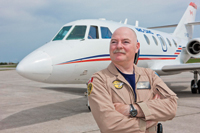
Features
Operations
45º42 North: Evaluating the ideas of tomorrow
Adjacent to the Ottawa Airport in leafy surroundings that would not be out of place on a university campus is the National Research Council’s Flight Research Laboratory at Uplands. Established to adapt postwar American and British aircraft designs to Canadian needs, the NRC’s Institute for Aerospace Research (IAR) has been conducting research into aerodynamics, gas turbines, and structures and materials performance since 1946.
July 6, 2011 By Peter Pigott
Adjacent to the Ottawa Airport in leafy surroundings that would not be out of place on a university campus is the National Research Council’s Flight Research Laboratory at Uplands. Established to adapt postwar American and British aircraft designs to Canadian needs, the NRC’s Institute for Aerospace Research (IAR) has been conducting research into aerodynamics, gas turbines, and structures and materials performance since 1946.
On the walls of the boardroom wall are photos of historic aircraft – a Mitchell bomber, an F-86, a “flying wing” and, of course, the Avro Arrow. In their day, all were used to test theories and/or equipment designed to make for safer, more capable aircraft. Flight tests have ranged from assessing rotorcraft-handling qualities to evaluating how modified equipment or degraded flight conditions can affect the performance of pilots and aircraft.
“What we do at NRC Aerospace are two research programs,” said its chief pilot Robert Erdos. “The first is the traditional aerospace engineering discipline of flight mechanics and avionics (i.e., building better aircraft). The other is airborne research, where we use the airplane to do a science, which could be geophysical, or electrical engineering such as radar or studies in meteorology for agriculture. In both cases, the common denominator is doing something with an airplane which has never been done before.”

|
Erdos came from the military and at the Lab he is able to combine his first love (flying) with his second (aeronautical research). “The five pilots in the NRC are all ex-Air Force test pilots that got out of the military but are still working for the federal government,” he says. “We take an experienced crew in a carefully instrumented aircraft and go into conditions that certified airplanes and operational crews would never experience. Simply put, we bridge the gap between theory and the market.”
The Laboratory maintains a small fleet of dedicated research aircraft to support projects in its main program areas: flight mechanics, avionics and airborne research experimentation. These flying test beds – spotless in gleaming white and blue with red stripes – are kept in an attached hangar. To the untrained eye, it all looks like an immaculately preserved collection of old aircraft – among them are helicopters, a Harvard and a Convair airliner. But none are what they appear to be and Erdos explains what each does. The holds of each of the innocuous-looking aircraft are crammed with complex instruments. The Bell 412 helicopter, for example, is unique in the world. As an Advanced Systems Research Aircraft, it is specially configured for research into digital fly-by-wire and fly-by-light control systems. Beside it is its sister Bell 205, an airborne simulator that can operate as a surrogate UAV (unmanned aerial vehicle). The Falcon 20 that once transported VIPs for the federal government (and starred in CBC’s The Rick Mercer Report) is actually a micro gravity research facility. The Convair 580 and Twin Otter are fitted with instrumentation to collect data on air pollution, severe weather, cloud formation and earth-atmosphere exchange of greenhouse gases. Older than all of the others is the meticulously maintained Harvard Mark IV. When the ex-RCAF trainer was built, no one could have imagined the future capabilities of its LCD glass cockpit which is used for airborne field experiments.
The IAR is working on a number of key projects, including:
- certification of the “Seawind” composite amphibian for AeroNautic Development Corp;
- installation of a high-bandwidth sat-com system on the Convair for military research;
- upgrades to the NRC’s Bell 412, to include a new FADEC PT6 engine and glass cockpit;
- implementation of a data acquisition system on the new Extra 300 research aircraft, which is planned for studies in human neuro-cognitive performance in dynamic environments.
When not at the NRC, Erdos can be found at Vintage Wings of Canada, flying the Hawker Hurricane, which, he says, “is reminiscent of prodding awake a dragon.” He says he has discovered why the 70-year-old aircraft is called the Hurricane.
The consummate pilot, Erdos personifies the spirit of the National Research Council’s Flight Research Lab.
Peter Pigott is a Wings writer and columnist.